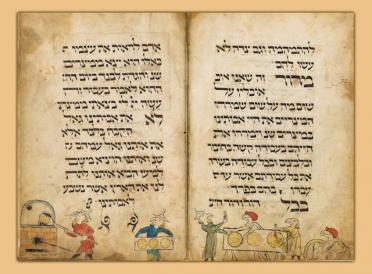Every week, parshaoftheweek.com brings you a rich selection of material on parshat hashavua, the weekly portion traditionally read in synagogues all over the world. Using both classic and contemporary material, we take a look at these portions in a fresh way, relating them to both ancient Jewish concerns as well as cutting-edge modern issues and topics. We also bring you material on the Jewish holidays, as well as insights into life cycle rituals and events...
The matza is, of course, central to Pessach; it is the main symbol of the exodus experience which we remember and reenact on the night of the Seder. It is, however, a complicated symbol. On the one hand, the matza is meant to symbolize the miraculous speed of the exodus, the fact that “the salvation of the Lord comes in the blink of an eye”; we left Egypt so quickly that the dough of the Israelites did not have time to rise. On the other hand, we begin the seder by announcing הא לחמא עניא – “this is the bread of affliction”, a reference to the fact that, as slaves, we were fed matzot by the Egyptians, because they were cheap, easy to ship and store, and filling. And so, the matza is both a symbol of our slavery and of our freedom, of our being oppressed in Egypt and of our miraculous escape from that oppression. And then we take the “bread of affliction” trope and turn it on its head by inviting whoever is hungry to come and share it with us: we are generous with our bread of affliction!
On top of these historical messages, there is also a layer of meta-historical meaning ascribed to the matza and its opposite – חמץ – leaven. While the matza is seen as pure, simple, and humble, and therefore it is (almost always) used in grain offerings in the Temple, leavened bread stands for arrogance, haughtiness, the evil inclination itself, and is therefore (almost always) forbidden for use in the Temple ritual. In this system, matza and hametz are not about the Egyptian exodus at all. Rather, they stand for no less than good and evil.
This multiplicity of meaning teaches us many things, but the most basic is this: our ability to make meaning. Our ability to take the objects in our lives, the things around us, the things we do and the things that happen to us, and invest them with meaning, resonance, weight, and importance. The fact that the Egyptians fed unleavened bread to their Israelite slaves is not “just the way it was”, an irrelevant detail in the Passover story. It can be used as a crucial window into the Egyptian experience. And, like a window, it affords a number of views. We can focus on the afflictions of slavery, or on the positive aspect of the humility and the humanity of the Jews as opposed to the decadence and sadism of the Egyptians. We can use it to remember the miraculous turn of events which took us out of Egypt, or to stand for the experience of slavery itself. And we can extrapolate beyond Egypt to the realm of absolute good and evil. What we can not do is just write matza off as a technical detail, a minor plot element, to be noted briefly and then ignored. We are asked to remember it, ponder it, and invest it with relevance and meaning. Meanings.
It is not surprising that the meanings we discover are multi-voiced, sometimes to the point of contradiction. Matza can be a good thing – the symbol of the speed of God’s salvation – or a bad thing – the bread of affliction. This is because life itself is multi-voiced. Experiences are complicated, contradictory, often best described as confusing, bittersweet, and unresolved. Our religious – and personal - responses to our history need to be the same, not simplistic or one dimensional, ideologically or intellectually rigid, but nuanced, multi valenced, and complex.
Another example of this is the custom of spilling drops of wine from our cups when we recite the ten plagues. Most early sources see the symbolism of this activity as distancing ourselves from the plagues; the wine we spill symbolizes the plagues, which we hope to not be effected by, so we remove them from ourselves as we remove the wine, directing it outwards, to the Egyptians and/or our other enemies. I distinctly remember a blood motif at work here – the wine representing the blood of the Egyptians - although I can not now seem to find that source (anyone out there know it?). A modern interpretation, however, sees this spilling as a diminishing of our joy – less wine to drink – out of sympathy for the fallen Egyptians. Although this seems to not have an ancient tradition behind it, I remember how, as a kid, I found it quite compelling, and still do.
The richness of the symbology of the matza, the wine spilling, and of the entire Seder, is a lesson in how we, the Jewish people are meant to understand and interpret our history. From the first, great event of our nation’s history, the exodus, to today’s headlines, we are meant to search out the meanings behind the details of what happens to us. To insist on one standard meaning, on one set of lessons to be learned, is to miss the point of how we are meant to remember our past, and process our present. Our task is to make as much meaning as we can out of what life hands us; not to keep it simple, but to realize it’s complicated.
Have a wonderful Pessach,
Shimon



Get inspired by Pesach Divrei Torah from previous years